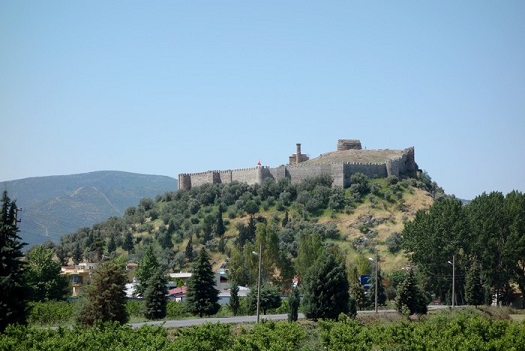Ayasuluk Castle, locally known as Ayasuluk Kalesi or Selçuk Kalesi, lies on a hill in the town of Selçuk, in the province of Izmir in Turkey. It is situated just a mile from the site of the ancient Greek city of Ephesus.
Ephesus was initially a harbour city but the continually silting up of its harbour eventually made it an inland site situated 5 km from the sea at present. At the beginning of the Byzantine era, Ephesus was still predominantly at its harbour location. During the 6th century the city declined and was split up. The old city at the harbour was enclosed by a defensive wall, making it considerably smaller and thus better to defend. The Ayasuluk hill had been part of the outskirts of the city and was now a mile outside the city.
The Byzantines then built Ayasuluk Castle, using stones from disused Greek and Roman buildings, for its construction. On the slope of the hill they built the Basilica of St. John. Defensive walls coming down from the castle, encompassed the basilica. Effectively turning the site in a citadel with the castle as an upper castle and the area with the basilica as a lower castle.
The combination of the marble façades and the mortared rubble made the walls 4 meters thick. The citadel walls were 1.5 km around with 17 towers. Entry to the citadel from the south was through the Gate of Persecution, which first led into the Basilica. In the 8th century the square towers on either side of the gate were made pentagonal, aiding in their defensive capabilities.
Over the following centuries, however, people from the harbour site gradually migrated towards the citadel on the hill as the harbour continued to silt up and they battled malaria. By the end of the Byzantine period the harbour was abandoned, and Ephesus was centered around Ayasuluk Hill.
In 1090 Ephesus was conquered by Seljuk Turks under Tengribirmish, but by then it had declined to nothing more than a small village. In 1097 the Byzantines took back control and renamed the village Agios Theologus. They kept control until the early 14th century. Then it was finally taken by the Seljuks, who renamed the site Ayasuluk. They repaired the walls of the castle, dredged the harbour and put it to use again. This resulted in the town prospering again.
Around the beginning of the 15th century Ayasuluk came under Ottoman rule. By that time the harbour had silted up again and had become a swamp. The town declined again to a village. The Ottomans however did keep the castle garrisoned. In the mid-17th century it had a garrison of 40 soldiers. As the population kept declining, the castle was abandoned during the 18th century. In 1914 Ayasuluk was renamed Selçuk.
A nice castle. Inside there are a small ruined mosque, a part of a former church turned into a cistern, a couple of Ottoman cisterns and groundplans of a couple of houses. It can be visited as a visitor of the site of the basilica. For that you have to pay a fee.
 |
| Eastern Roman Empire about 1025. Selçuk Fortress is located one mile from the ancient Greek city of Ephesus on the Aegean coast. |
 |
| The castle was built during the time of the Byzantine Empire and later remodeled by the Turks. |
 |
| The combination of the marble façades and the mortared rubble made the walls 4 meters thick. The citadel walls were 1.5 km around with 17 towers. |
(journey) (Ayasuluk) (ayasuluk castle)















